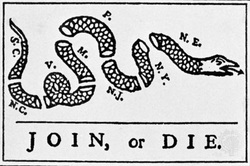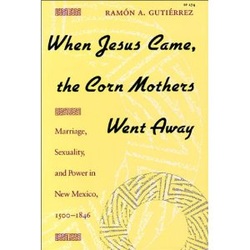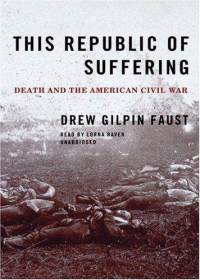Welcome to Early American History at OCU

This course explores American history from contact through Reconstruction by asking students to "think like a historian" and answer questions about American history that resonate in modern society, culture, and politics. As an Honors class, this section of early American history focuses on a particular topic: religion and faith in early America. Throughout the semester, students will be reading four historical monographs that link, in one way or another, to issues of faith, spirituality, or religion in North America.
Throughout the semester, students will be posting their reflections in a series of thought pieces written for this website. We hope that the site might serve as discursive outlet for class topics, since most of our in-class activities will focus on seminar-like discussions of the material.
This is our first semester using the web as a major component in class discussion, as several students in the class cannot physically join us for our in-class sessions. Consequently, the website will feature both reading prompts from students spread across the country, and reflections from students on the Oklahoma City University campus. In the world of cyberspace, seemingly anything is possible. If you are not enrolled in the course but would like to respond to our posts, please email the course instructor at [email protected]
To begin, the class is reading When Jesus Came, the Corn Mothers Went Away: Marriage, Sexulaity, and Power in New Mexico, 1500-1846 by Ramon Gutierrez.
Throughout the semester, students will be posting their reflections in a series of thought pieces written for this website. We hope that the site might serve as discursive outlet for class topics, since most of our in-class activities will focus on seminar-like discussions of the material.
This is our first semester using the web as a major component in class discussion, as several students in the class cannot physically join us for our in-class sessions. Consequently, the website will feature both reading prompts from students spread across the country, and reflections from students on the Oklahoma City University campus. In the world of cyberspace, seemingly anything is possible. If you are not enrolled in the course but would like to respond to our posts, please email the course instructor at [email protected]
To begin, the class is reading When Jesus Came, the Corn Mothers Went Away: Marriage, Sexulaity, and Power in New Mexico, 1500-1846 by Ramon Gutierrez.
When Jesus Came, the Corn Mothers Went Away

We began the semester examining When Jesus Came, the Corn Mothers Went Away. Although the class met only twice due to inclement weather in Oklahoma, we were still able to accomplish much in analyzing the material for both content and its connections to the historical profession. The class was led initially to believe that we were merely reading the book for content--an examination into the lives of Pueblo society and the role of the Catholic Church in the early conquest of North America. We discussed the difference between Pueblo spiritual practices and those of Europeans and examined the strategies of Franciscan Friars in conquering through conversion. Students were asked to reflect upon the first two-thirds of the books in a series of short responses (posted under the tab for the book above). These reflections demonstrated a close reading of the material and intrigue into the author's findings, but not an critical examination of the author or the book itself.
Prior to completing the book, I informed the class that the book was chosen for a second purpose. They were asked to read two sets of critiques about the work--"Commentaries: When Jesus Came, the Corn Mothers Went Away: Marriage, Sex, and Power in New Mexico," American Indian Culture and Research Journal 17:3 (1993), 141-177; and "Subaltern Historiography on the Rio Grande: On Gutierrez's 'When Jesus Came, the Corn Mothers Went Away," American Ethnologist 21:4 (Nov. 1994), 892-899. Instead of evaluating content, I asked students to think about the role of academic historians based on our opening discussion of the semester--based on the opening chapter to Sam Wineberg's Historical Thinking and Other Unnatural Acts. Students responses to these new readings revealed a sense of awe and appreciation of the difficult job of historians--both as authors and critics. (See responses under Critical Thinking tab above.)
As we move forward, the class will both focus on examining the history of religion in the founding of the nation--with a focus on the issue of the separation of church and state--and attempt to critically analyze historical monographs as the interpretations of real-life academic historians.
Prior to completing the book, I informed the class that the book was chosen for a second purpose. They were asked to read two sets of critiques about the work--"Commentaries: When Jesus Came, the Corn Mothers Went Away: Marriage, Sex, and Power in New Mexico," American Indian Culture and Research Journal 17:3 (1993), 141-177; and "Subaltern Historiography on the Rio Grande: On Gutierrez's 'When Jesus Came, the Corn Mothers Went Away," American Ethnologist 21:4 (Nov. 1994), 892-899. Instead of evaluating content, I asked students to think about the role of academic historians based on our opening discussion of the semester--based on the opening chapter to Sam Wineberg's Historical Thinking and Other Unnatural Acts. Students responses to these new readings revealed a sense of awe and appreciation of the difficult job of historians--both as authors and critics. (See responses under Critical Thinking tab above.)
As we move forward, the class will both focus on examining the history of religion in the founding of the nation--with a focus on the issue of the separation of church and state--and attempt to critically analyze historical monographs as the interpretations of real-life academic historians.
Awash in a Sea of Faith and The Founding Fathers and the Place of Religion in America
In the second part of the class, we will examine two books that cover roughly the same time-span in American history. Students will compare the two works, examine the time periods within which they were written, and reflect upon the meaning of religion and the founding fathers in contemporary society. Comparative essays will appear in the tab above titled, Butler and Lambert on Early American Religion.
This Republic of Suffering

As each course experiences its own life cycle, it may be most appropriate to end this class with a book on death. In This Republic of Suffering, Drew Gilpin Faust chronicles changes in the way that Americans understood death and dying during the Civil War. How could Americans have gone to war and killed wach other in numbers unimaginable up to this point in history? How did their spirituality influence the ways in which they understood wholesale death? How did mass casualties shape American spirituality? And finally, how did the deaths of nearly 620,000 Americans (by the hands of other Americans) mold a post-war government?

